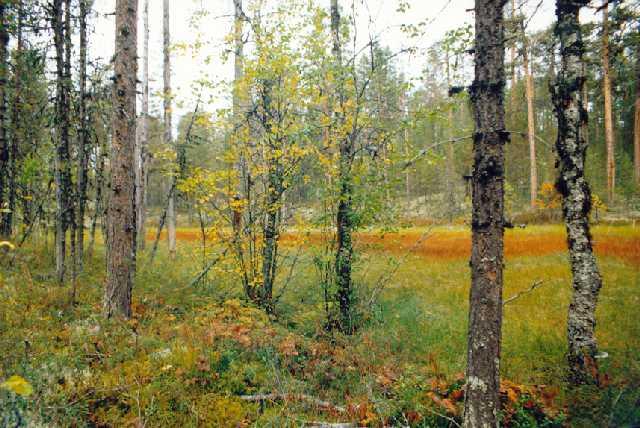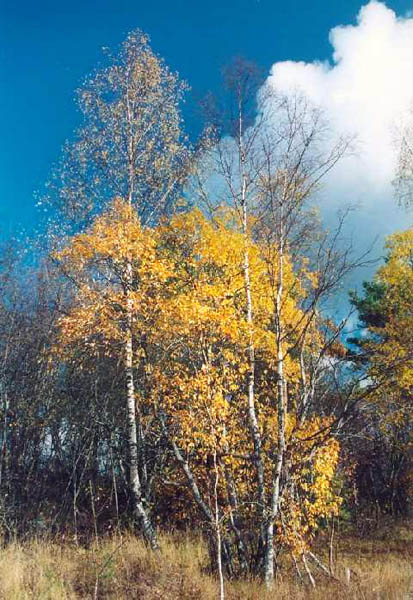 The leaving of last glacier has not only formed a relief of the territory of Karelia, but also its soil-vegetable cover. The coniferous woods prevail in the territory of the Republic. On heights in northern areas retain their tundra kinds, in taiga massifs – ordinary fir and pine trees, and also Finnish and Siberian fir trees; from deciduous trees everywhere grow a birch, aspen and alder.
The leaving of last glacier has not only formed a relief of the territory of Karelia, but also its soil-vegetable cover. The coniferous woods prevail in the territory of the Republic. On heights in northern areas retain their tundra kinds, in taiga massifs – ordinary fir and pine trees, and also Finnish and Siberian fir trees; from deciduous trees everywhere grow a birch, aspen and alder.
Only in the south of Karelia whole areas of deciduous kinds could be met, such as maple, black alder-tree, lime-tree and elm.
The taiga pine woods are remarkable for mighty mossy cover and an abuncance of bushes. The undergrowth is juniper and ashberry. On bare slopes of rocks and on tops of knolls and ridges are spreading out white-mossed pineries. Fir plantations prefer richer soils.
On the places, which have burnt out from wood fires or were cut down, secondary forests are rapidly increasing, especially deciduous trees with rich herbage.
In southern woods of Karelia, especially in Zaonezhskom peninsula and in Prionezh’e, sometimes it is possible to see small territories of a Karelian birch, though it more frequently grows by separate trees, in structure of ordinary birch woods.
 The Karelian birch is a small tree with bumpy rough or ribbed trunk, and it belongs to the number of the most valuable wood breeds of the world. The Karelian birch has become famous for beautiful and patterned wood, which is so highly valued among cabinet-makers. The products from the Karelian birch with equal success can be met both in the Karelian houses, and in the well-known palaces and museums. There is the largest reserve of this birch near the village of Martial Waters in Karelia.
The Karelian birch is a small tree with bumpy rough or ribbed trunk, and it belongs to the number of the most valuable wood breeds of the world. The Karelian birch has become famous for beautiful and patterned wood, which is so highly valued among cabinet-makers. The products from the Karelian birch with equal success can be met both in the Karelian houses, and in the well-known palaces and museums. There is the largest reserve of this birch near the village of Martial Waters in Karelia.
One third of the territory is occupied by waterlogged woods and swamps: high-lying bogs (fed by atmospheric precipitation) and low-lying bogs (filled with drains and underground waters). They can be reservoirs, covered with thick interweaving of plants on the top, or significant green-grey spaces, covered with green moss, accompanied by rare wilted trees.
The rocky plants are represented by crusted lichens of different colors – black, brown, yellow, red; ferns and flowers nestle in hollows.
Both the woods and the swamps are rich in red bilberry, bilberry, cranberry, cloudberry, and strawberry; rare – great bilberry, stone berry, and of course, the Queen of the Karelian open spaces – raspberry. mushrooms are very popularand during productive years, start with spring morel and finish with autumn mossiness mushroom.
It is enough to recall the fact that in the 19th century from Olonetskoi province to St. Petersburg was delivered up to 1.500 supplies of dry mushrooms per year. Nowadays, harvests are less, but in any, even in the driest year, a mushroom picker always will manage to find a pair or two baskets of selected mushrooms.
The tourist, who would like to engage in preparation of forests’ gifts (it doesn’t include only mushrooms and berries, but also food plants and herbs), should first of all carefully become familiar with The Red Book of Karelia not to harm reproduction of rare, disappearing and protected kinds, and, that is important, to know precisely poisonous mushrooms and plants.
